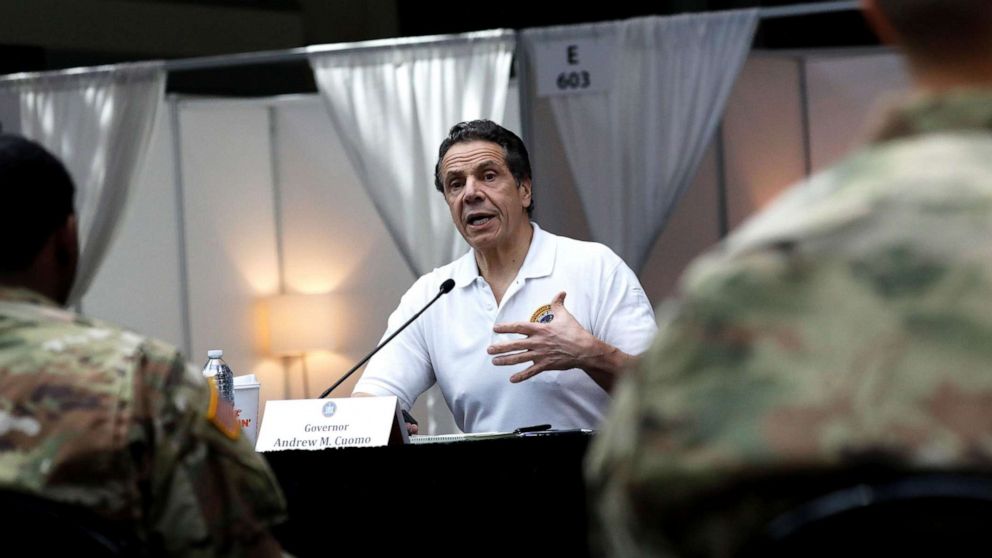[ad_1]
New York — which has become the epicenter of the coronavirus pandemic’s spread in the U.S.– will now be on June 23, the latest state to postpone or drastically change the status of its April 28 presidential primary.
Six states slated to vote that day have delayed or moved to expand absentee voting to continue on with their elections in the midst of the health emergency.
“I don’t think it’s wise to be bringing a lot of people to one location to vote. A lot of people touching one door knob, a lot of people touching one pen, whatever you call it — device on the ballots. So, we are going to delay that, and link it to an election that was previously scheduled on June 23,” New York Gov. Andrew Cuomo said during a press conference on Saturday that he’s postponing the state’s presidential primary to the same date of the state’s down ballot primary elections.
New York was the only state originally scheduled to hold its presidential contest on April 28 – the so-called “Acela Primary.”
Maryland, Connecticut, Rhode Island, Delaware and Pennsylvania are all now voting on June 2.
One potential problem for New York, however is that, June 23 is after June 9, the Democratic National Committee cutoff date for states to hold nominating contests. States that move outside the window could face a penalty of up to a 50% reduction in delegates.
New York has the second-most delegates of any state with 274. Louisiana and Kentucky have also moved their elections outside the approved window.
The New York State Election Commissioners Association, along with other voting access groups, had called on Gov. Andrew Cuomo to consolidate the state’s presidential primary election with another primary set for June 23, and argued that the additional time would allow counties to properly prepare and organize around a potentially very different method of voting.
Many issues contributed to what the commission said would be a difficult election to pull off, according to the organization’s president Kelly Penziul. Closed polling sites, lack of poll workers and public health concerns are at the top of the list.
“It’s going be kind of tough to pull this off if we have to stay with April 28. The fact is we don’t want to jeopardize the health of our employees,” Penziul told ABC News prior to Cuomo’s announcement. “You can’t quarantine people and then turn around and say, ‘Oh yeah, by the way, there’s an election, go vote.’ You really can’t do that in my eyes at all.”
Other states scheduled to vote late April are expanding their absentee voting process to make sure ballots get cast. Ohio enacted similar changes which would allow for no-excuse absentee voting up until April 28, although some groups argued that the turnaround time is too short for that fix to be sufficient.
“That’ll be a challenge. We have to know that. I don’t think we can go to total absentees because we’d never be able to handle that, especially in the big cities,” Anthony Scannapieco, the Republican caucus chairman for the commissioners association previously said.
Common Cause New York, a voting rights group, had called on Gov. Cuomo and state officials to consolidate the primary, contending that officials have made it clear that they won’t have the bandwidth to conduct an entirely absentee election by late April.
“We don’t have the infrastructure in place to do it quite frankly, so that’s anything from having enough paper to print all the ballots, to making sure that we have prepaid postage, to make sure folks can return their ballot. It’s a lot of smaller logistical decisions and preparations that would need to have started weeks ago,” Sarah Goff, the deputy director of Common Cause New York had previously said.
To switch to an all-mail election requires years of transition periods, John Conklin of the New York State Board of Elections said, citing states that have used multiple cycles to make that switch.
“A lot of the states that do vote by mail didn’t do it overnight, didn’t do it in a single election. They built to it over time. It had expanded vote by mail over multiple election cycles and even multiple years,” Conklin said. “So, I think that would be a drastic change for our system, and would require a lot of changes.”
Since counties frequently utilize public facilities — many of which are closed due to coronavirus concerns — officials were worried that if the April 28 day of voting did proceed, there would be nowhere to hold elections.
Penziul said that under the previous orders from Gov. Cuomo, it would be impossible to open any of her current polling sites in a way that would prevent large gatherings.
“You have whole sites themselves that are becoming unavailable: schools, public buildings, places that are being shut down,” Conklin said.
The concerns about processing absentee ballots factors into staffing as well. Approximately 55% of poll workers are over the age of 60 in New York, Conklin said, putting many of those who administer the election at risk of contracting or spreading the disease.
New York State Attorney General Letitia James had also called for no-excuse absentee voting, which the state does not currently offer, in order to allow the April 28 election to continue.
“Voters shouldn’t have to choose between their health and the right to cast a ballot,” James said in a press release. “If we act now, we have more than a month before the presidential primary and numerous special elections across our state to take action and ensure every eligible New York voter receives an absentee ballot.”
ABC News’ Quinn Scanlan contributed to this report.
[ad_2]
Source link

